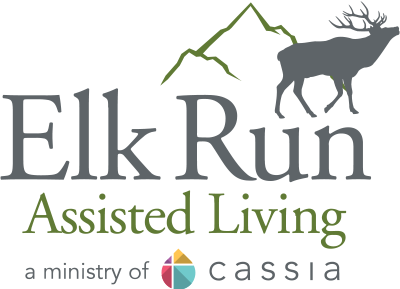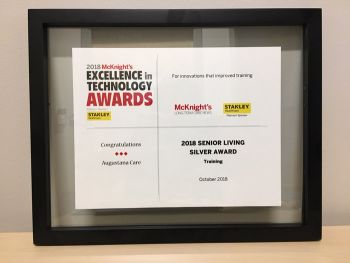Applied technology makes new headway in this sector
Although it may seem so, technology isn’t only for young people. It can also make a huge difference in the lives of older adults. Most of us want to age in place and live as independently as possible, whether we’re approaching age 70, 80, 90, or 100. Technology can help, but most caregivers and older adults don’t know how to find, much less use technology to their benefit.
Augustana Elim Care Services Learning Lab for Eldercare Technology, which recently received the 2018 McKnight’s Senior Living Technology Silver Award in the Training Category, can help. You can learn more about the awards in this article.
“In the highly competitive senior living sector, applied technology is becoming both a differentiator and a game changer,” said John O’Connor, Editorial Director for McKnight’s. STANLEY Healthcare was the event’s Platinum Sponsor. MatrixCare sponsored the Senior Living track.
The Lab serves older adults who are entering a stage when friends and family may not be living nearby and new sources of stimulation and companionship are needed. The Lab can also help people with age-related changes in hearing, sight and memory and other physical and psycho-social-emotional functions.
By 2020, the number of U.S. citizens who will likely need some level of care will reach approximately 117 million. It’s estimated there will be only 45 million people to provide that care and almost one-third of them will be doing so remotely, according to AARP. In Minnesota the impact of this care gap will be felt acutely, as it trails only Hawaii in the longevity of its residents. Due to rising annual costs in residential care (averaging $37K─$87K depending on the level of care), the Learning Lab strives to connect technology tools with people who want to age in place.
The Learning Lab opened its doors in April 2017 in the Cora McCorvey Health and Wellness Center in the historic Near North neighborhood of Minneapolis. Under the leadership of CEO Tim Tucker, with funding from a Minnesota DHS Live Well At Home grant, Augustana Care stepped into the role of innovator in gerontechnology health and education. Within its first 14 months of active programming, The Lab engaged with hundreds of organizations, either in the Lab or through presentations in the community, and responded to more than 200 individual, family and other provider requests for direct service.
Requests are quite varied and frequently require a substantial amount of research, including referrals to experts such as occupational, physical and assistive technology therapists, vision and speech/language specialists, technology developers, specialized vendors and others. Examples of requests include helping care partners (both informal and formal):
- Help to identify safety options for people whose memory loss causes them to wander and become lost
- A review of available medication reminders and dispensers both for people who self-manage their meds or have others to assist
- Assistance investigating how the Amazon Alexa and the Canary security camera can be used call for help in an emergency.
The Learning Lab introduces families, service providers, policy makers and others to technologies in five general silos. Given the right “fit,” they can all help make life safer, healthier, easier and more connected by supporting independence AND reducing isolation. Doing so has been shown to increase the amount of time that people, including caregivers, live fully and actively in later life.
Health technologies are devices that help people monitor and manage their fitness and health from home. Examples include automatic medication reminders and dispensers, blood pressure, heart rate and sleep monitors, online medical portals like MyChart and remote doctor visits.
Safety technologies involve devices and related technologies, like apps and monitoring services, designed to help people be safe at home and out in the community. Examples are interior and exterior video cameras, fall detectors with call systems, GPS trackers, sensors that automatically shut off unattended appliances and many types of special lighting.
Education technologies use devices like smartphones, tablets and computers to help users access information and educational content, whether it’s saved on a media storage device or available on the internet. Examples of internet content would be the MN Senior Linkage Line and the Mayo Clinic and Alzheimer’s Association websites.
Social technologies also use devices like smartphones and computers that help users communicate. Some, like Facebook or Facetime, are fun for keeping friends and family groups connected. Others are robust communication systems for scheduling and tracking appointments and sharing critical information securely. Telepresence robots are emerging into this category.
Environmental technologies make it possible for people to control systems in their home environments―lighting, temperature, security, entertainment, others―using voice commands or apps. Amazon Alexa and Google Home are common artificially intelligent Wi-Fi-enabled technologies used alone or paired with lamps, thermostats, cameras, TVs and other devices to regulate the environment.

